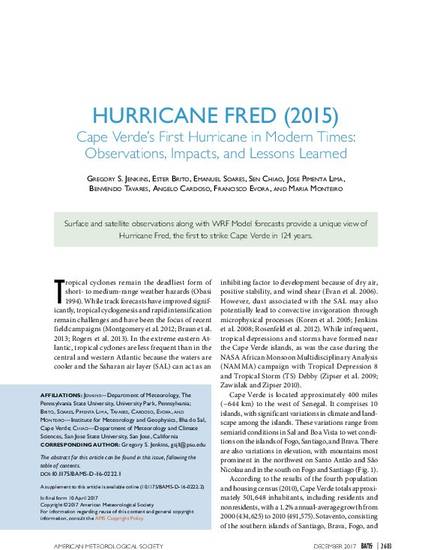
Article
Hurricane Fred (2015): Cape Verde's first Hurricane in modern times: Observations, impacts, and lessons learned
Bulletin of the American Meteorological Society
(2018)
Abstract
During 31 August 2015, Hurricane Fred traversed through the Cape Verde islands, passing near Boa Vista and possibly making landfall over São Nicolau during the evening hours. Hurricane Fred was a category 1 storm with maximum winds of 75 kt and a sea level pressure of 986 hPa during 31 August. The African easterly wave associated with Tropical Cyclone (TC) Fred emerged from Guinea on 29 August and was named Tropical Storm Fred on 30 August. Prior to impacting Cape Verde, the storm caused the sinking of a ship and the loss of seven lives off the coast of Guinea-Bissau and damage along coastal zones of Senegal. In Cape Verde, there was no loss of life but there was damage on 7 of the 10 islands. Station data show tropical-storm-force winds in Boa Vista and Sal and hurricane-force winds in São Nicolau. Heavy precipitation with amounts in excess of 200 mm occurred on the islands of Santiago, São Nicolau, and Santo Antão. The Weather Research and Forecasting (WRF) Model and Global Forecast System (GFS) were used as primary guidance several days prior to the formation of TC Fred. Challenges for protecting populations from tropical cyclones can be addressed through annual hurricane awareness and preparedness programs in several languages. This is also an adaptation strategy related to anthropogenic climate change as warming tropical oceans may increase the risk of damage and threaten populations. Radar and buoy observations are needed now, and the movement of vulnerable populations and other adaptation strategies will need to be implemented in the coming decades.
Disciplines
Publication Date
January 3, 2018
DOI
https://doi.org/10.1175/BAMS-D-16-0222.1
Publisher Statement
SJSU users: Use the following link to login and access the article via SJSU databases.
This article was published in the Bulletin of the American Meteorological Society, volume 98, issue 12, 2018, and can also be found online here.
© Copyright 2018 American Meteorological Society (AMS). Permission to use figures, tables, and brief excerpts from this work in scientific and educational works is hereby granted provided that the source is acknowledged. Any use of material in this work that is determined to be “fair use” under Section 107 of the U.S. Copyright Act or that satisfies the conditions specified in Section 108 of the U.S. Copyright Act (17 USC §108) does not require the AMS’s permission. Republication, systematic reproduction, posting in electronic form, such as on a website or in a searchable database, or other uses of this material, except as exempted by the above statement, requires written permission or a license from the AMS. All AMS journals and monograph publications are registered with the Copyright Clearance Center (http://www.copyright.com). Questions about permission to use materials for which AMS holds the copyright can also be directed to permissions@ametsoc.org. Additional details are provided in the AMS Copyright Policy statement, available on the AMS website (http://www.ametsoc.org/CopyrightInformation).
Citation Information
Gregory S. Jenkins, Ester Brito, Emanuel Soares, Sen Chiao, et al.. "Hurricane Fred (2015): Cape Verde's first Hurricane in modern times: Observations, impacts, and lessons learned" Bulletin of the American Meteorological Society Vol. 98 Iss. 12 (2018) p. 2603 - 2618 ISSN: 1520-0477 Available at: http://works.bepress.com/sen_chiao/39/
